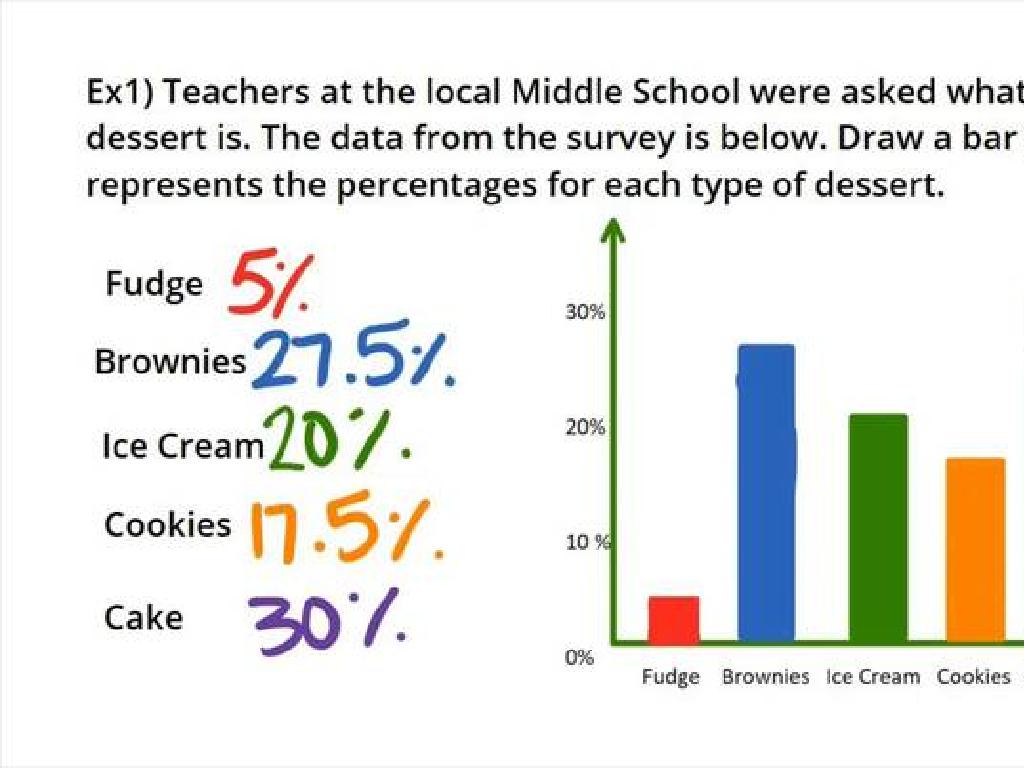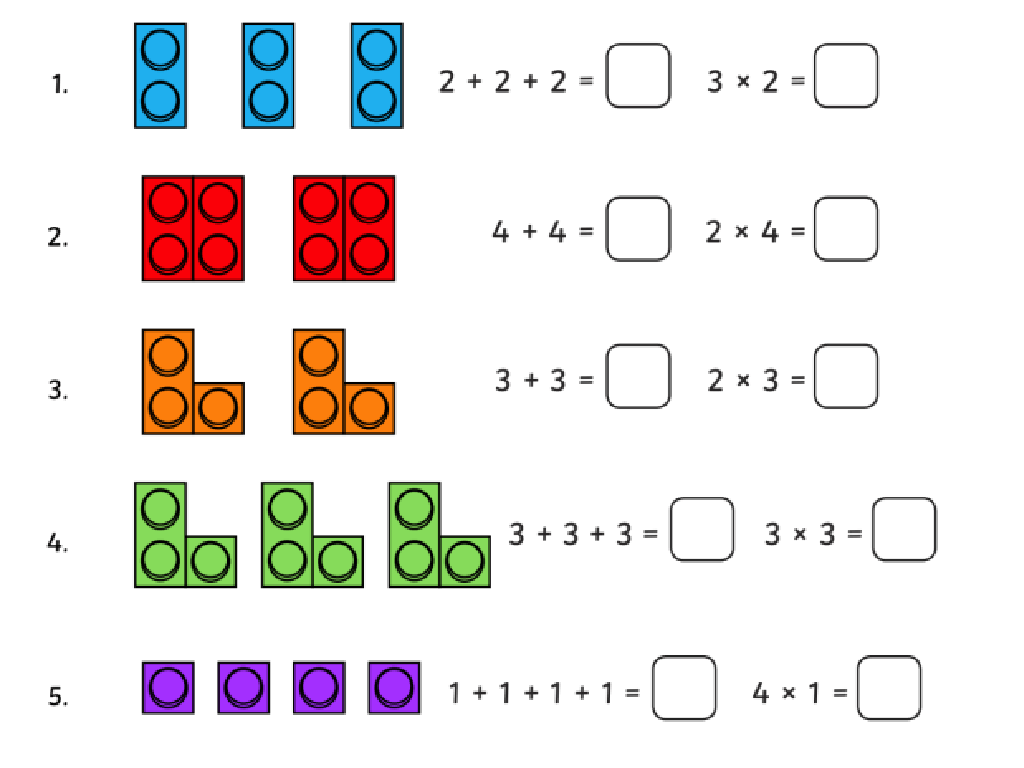Multiply A Decimal By A One-Digit Whole Number
Subject: Math
Grade: Fifth grade
Topic: Multiply Decimals By Whole Numbers
Please LOG IN to download the presentation. Access is available to registered users only.
View More Content
Multiplying Decimals: The Basics
– Grasping the concept of decimals
– Decimals represent parts of a whole, like 0.5 is half
– Multiplication: Combining groups
– To multiply is to add a number to itself a certain number of times
– Significance of decimal multiplication
– It’s crucial for math in everyday life, like money calculations
– Practical applications
– Used in measuring, shopping, and cooking
|
This slide introduces the fundamental concepts needed to understand multiplying decimals. Begin by explaining what decimals are and how they represent fractions of a whole, which is a concept students should be familiar with. Then, describe multiplication as the process of adding a number to itself repeatedly, and how this applies when working with decimals. Emphasize the importance of learning to multiply decimals, as it is a skill they will use frequently in real-life situations involving money, measurements, and more. Provide examples such as calculating change, measuring ingredients for a recipe, or determining the length of an object. Encourage students to think of other areas where they might need to use decimal multiplication.
Review of Multiplication Facts
– Recap multiplication tables
– Multiply whole numbers
– Engage in multiplication quiz
– A fun quiz to test your skills!
– Discuss quiz outcomes
– We’ll review the quiz answers together
|
Begin the lesson with a quick review of multiplication tables to refresh the students’ memory. This will help them feel more confident when multiplying decimals later on. Then, move on to multiplying whole numbers, ensuring that students understand the process since it’s similar to multiplying decimals. Introduce the multiplication quiz as a fun activity to apply what they’ve learned. After the quiz, discuss the outcomes with the class, going over any mistakes to reinforce learning. This activity will not only assess their understanding but also prepare them for the next step: multiplying decimals by whole numbers.
Understanding Decimals and Multiplication
– What is a decimal?
– A decimal represents a part of a whole, like 0.5 is half.
– Decimal places: tenths, hundredths
– Each place after the decimal point has a value: 0.1 is tenths, 0.01 is hundredths.
– Comparing decimals and whole numbers
– Decimals are smaller than whole numbers; 0.75 is less than 1.
– Multiplying decimals by whole numbers
– To multiply, align the numbers and multiply as with whole numbers, then place the decimal in the product.
|
This slide introduces the concept of decimals to fifth graders, explaining what decimals are and how they are structured with places like tenths and hundredths. It’s important to show how decimals compare to whole numbers, emphasizing that they represent parts of a whole. When multiplying a decimal by a whole number, the process is similar to multiplying whole numbers, but students must remember to place the decimal point correctly in their answer. Use examples to illustrate these points, such as multiplying 0.3 (three-tenths) by 4, and ensure students understand the concept of ‘carrying over’ as they would with whole number multiplication.
Multiplying Decimals by Whole Numbers
– Steps for decimal multiplication
– Ignore the decimal point and multiply as whole numbers. Then, put the decimal point back in the answer.
– Example: Multiply 0.5 by 4
– 0.5 (like 5) times 4 equals 20. Place the decimal to get 2.0 or just 2.
– Practice: Multiply 0.7 by 3
– Try multiplying 7 by 3. Where does the decimal go in the answer?
|
This slide introduces the concept of multiplying a decimal by a one-digit whole number. Start by explaining the steps: treat the decimal like a whole number to multiply, then place the decimal in the product. Use the example of 0.5 x 4 to show the process, emphasizing the placement of the decimal in the final answer. Provide a practice problem, 0.7 x 3, for students to apply the concept. Encourage students to work it out on their own, then discuss the correct placement of the decimal point in the answer. The goal is for students to understand the multiplication process and accurately determine the position of the decimal in their product.
Visualizing Decimal Multiplication with Number Lines
– Understanding decimal multiplication
– Number lines as a visual tool
– Number lines help us see the distance between numbers.
– Activity: Decimal placement on number lines
– Place decimals on a line and see how they relate to whole numbers.
– Practice multiplying with number lines
– Multiply decimals by whole numbers using the number line steps.
|
This slide introduces the concept of multiplying decimals by using number lines, a visual method that helps students understand the process. Begin by explaining how multiplication is similar to adding a number repeatedly. Show how a number line can represent this by marking the increments of the decimal being multiplied. For the activity, have students place various decimals on a number line and then visually represent the multiplication of these decimals by a one-digit whole number. Encourage students to share their number lines and discuss the patterns they observe. Provide several examples and guide them through the process step by step to ensure comprehension.
Let’s Practice Multiplying Decimals!
– Multiply: 0.3 x 5
– Example: 0.3 times 5 equals 1.5
– Multiply: 2.4 x 2
– Example: 2.4 times 2 equals 4.8
– Pair up for group activity
– Solve decimal problems together
– Share different methods and answers
|
This slide is designed to engage students in hands-on practice with multiplying decimals by whole numbers. Start by demonstrating the first example on the board, showing how to multiply a decimal by a one-digit whole number. Then, have the students attempt the second example independently. Afterward, organize the class into pairs for a group activity where they solve similar problems together. This collaborative approach allows students to discuss their strategies and understanding of the concept. As a teacher, circulate the room to offer guidance and ensure that each pair is on the right track. Encourage students to explain their reasoning to their partner, reinforcing their learning through teaching.
Common Mistakes in Decimal Multiplication
– Aligning decimal points correctly
– Ensure decimals are aligned before multiplying
– Placing the decimal in the answer
– After multiplying, the decimal should be as many places from the right as the total in the question
– Tips to avoid mistakes
– Double-check your work by estimating the answer
|
This slide addresses common errors students make when multiplying decimals by whole numbers. Emphasize the importance of aligning decimal points vertically for clarity before beginning multiplication. Stress that the placement of the decimal in the product is crucial and is determined by the number of decimal places in the original numbers. Provide tips such as estimating the answer first to check if the decimal is placed correctly in the final answer. Encourage students to practice with different problems and to always review their steps to reinforce these concepts.
Class Activity: Decimal Multiplication Game
– Understand game rules
– Collaborate in small groups
– Solve decimal multiplication problems
– Use multiplication skills to find the product of decimals and whole numbers
– Discuss answers with the class
– Explain your reasoning and learn from others
|
This interactive game is designed to help students practice multiplying decimals by one-digit whole numbers. Divide the class into small groups and provide each group with a set of decimal multiplication problems. Students will work together to solve the problems, encouraging teamwork and collaborative learning. After completing the problems, each group will share their answers with the class, allowing students to explain their thought process and learn from each other. This activity will reinforce their understanding of decimal multiplication and provide an opportunity for peer learning. Possible activities include: a multiplication relay race, a matching game with decimal and product cards, a ‘bingo’ game with decimal multiplication, or a ‘solve and swap’ where students exchange problems after solving.
Homework and Next Steps
– Practice with homework problems
– Solve problems to reinforce today’s lesson
– Preview: Multiplying two decimals
– Get a sneak peek at the next topic
– Keep up the great work!
– Your hard work is paying off!
– Questions are stepping stones
– Don’t hesitate to ask if you’re unsure
|
This slide aims to provide students with clear next steps after the lesson on multiplying a decimal by a one-digit whole number. The homework will consist of practice problems that reinforce the day’s learning, ensuring students solidify their understanding. Additionally, give students a brief preview of the upcoming lesson on multiplying two decimals to pique their interest. Always end with positive reinforcement to motivate students and remind them that questions are an essential part of the learning process. For the next class, prepare diverse problems that cater to different learning speeds and encourage peer discussion to facilitate collaborative learning.






